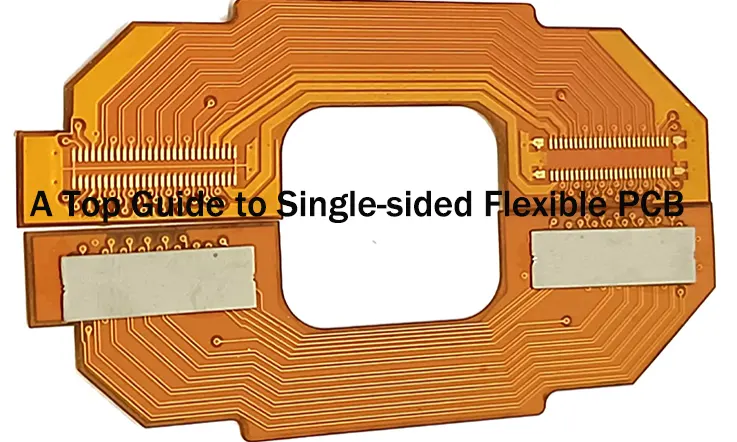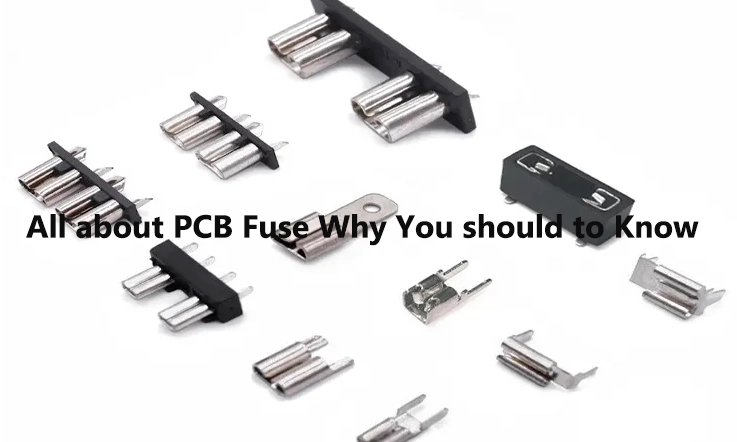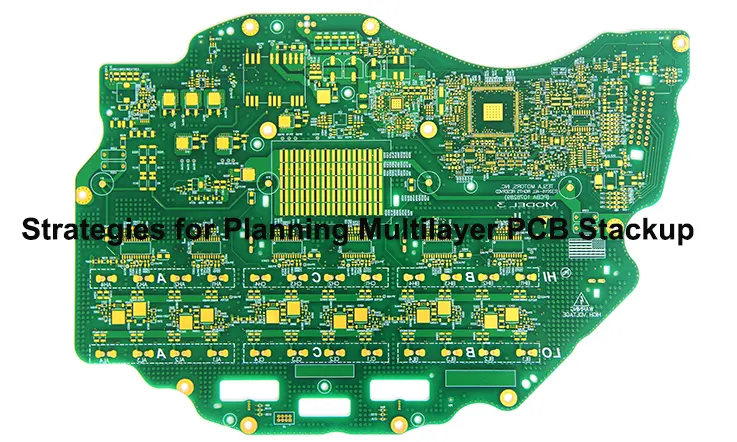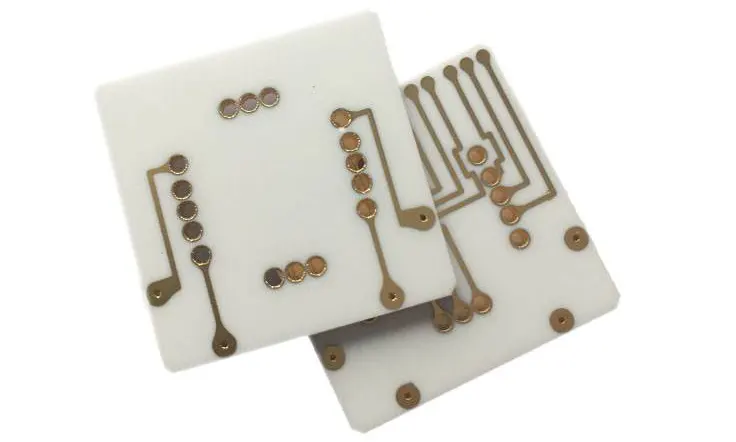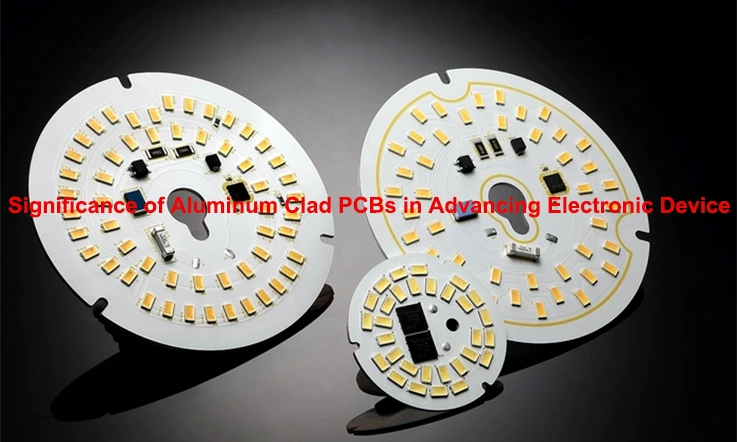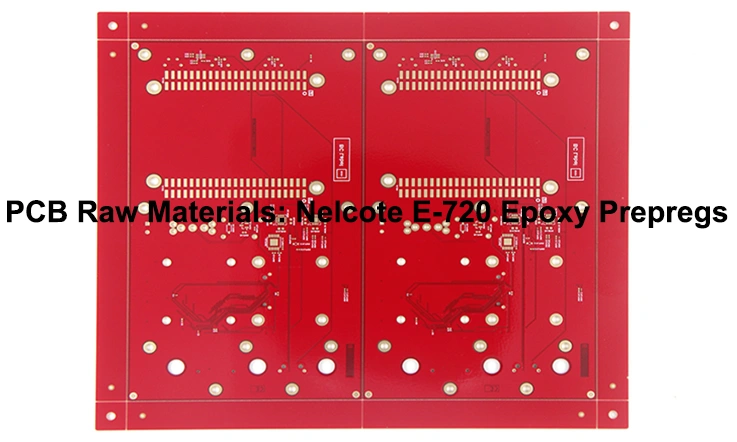
In sectors with stringent requirements for circuit performance and long-term operation—aerospace, automotive electronics, high-frequency communications, and advanced medical devices—standard FR-4 substrates often fail to meet complex design objectives. Nelcote E-720, a high-performance modified epoxy resin system, offers a proven path to achieving these objectives. Unlocking the full potential of this advanced material requires far more than an interpretation of its datasheets. Success stems from a command of its nuanced characteristics during the fabrication process.
This guide provides a comprehensive technical framework, analyzing Nelcote E-720 in-depth from the perspective of circuit board fabrication. Substrate selection directly dictates a circuit’s manufacturability, signal performance, and thermal endurance.
Understanding Nelcote E-720: Material Composition and Properties
In the fabrication of high-reliability multilayer printed circuit boards (PCBs), the selection of specific prepreg and laminate combinations is a deliberate engineering choice. The Nelcote E-720 material system offers a range of resin and reinforcement options, allowing for stackup customization for targeted thermal, electrical, and mechanical performance. This section examines how resin formulations and reinforcement fabrics dictate lamination behavior, registration accuracy, and long-term operational stability.
Resin Chemistry: The Advantages of E-720’s Modified Epoxy
The modified epoxy within Nelcote E-720 is formulated for predictable behavior under the heat and pressure of lamination. For fabrication flows that demand controlled resin flow and minimal void formation around via barrels and inner-layer features, this resin system enables thorough wet-out and fill between layers.
●Extended Out-Times: Offers extended workability windows, simplifying complex layup and vacuum staging procedures in cleanroom settings without material degradation.
●Controlled Cure Window: Exhibits a defined softening and curing profile, which mitigates common lamination defects such as delamination, dry interfaces, and resin starvation.
●Post-Cure Heat Tolerance: Its post-cure thermal stability makes it suitable for boards exposed to extended thermal aging, such as those in engine control units or high-frequency base stations.
●Assembly Survivability: The resin system is adapted for operations where board flatness, peel strength, and interlayer bonding must be maintained through multiple solder reflow cycles.
Reinforcement Fabrics: A Comparison of Fiberglass and Quartz
The choice of reinforcement fabric—typically fiberglass or quartz—governs the board’s electrical performance, dimensional stability, and dielectric behavior. Within the context of Nelcote E-720, each fabric serves distinct use cases for signal-sensitive or thermally dynamic environments.
●Fiberglass: Remains the standard for many multilayer designs, offering a solid blend of mechanical properties and cost-efficiency. It supports robust drilling and plating operations and is available in various weave styles (e.g., 106, 1080, 2116, 7628) to control dielectric thickness and resin content.
●Quartz Fabric: Excels in applications demanding superior dielectric properties. It is specified for phased-array radar, millimeter-wave circuits, and mixed-signal boards where minimizing skew and signal loss is a primary objective. The lower dielectric constant (Dk) variability and smoother surface of quartz fabric contribute to more repeatable signal path performance.
●Fabrication Implications: From a fabrication standpoint, both reinforcements process cleanly with the E-720 prepreg. Quartz, however, may require adjusted thermal ramp profiles during lamination to achieve optimal flow balance and consolidation quality.
Core Performance Advantages in Demanding Environments
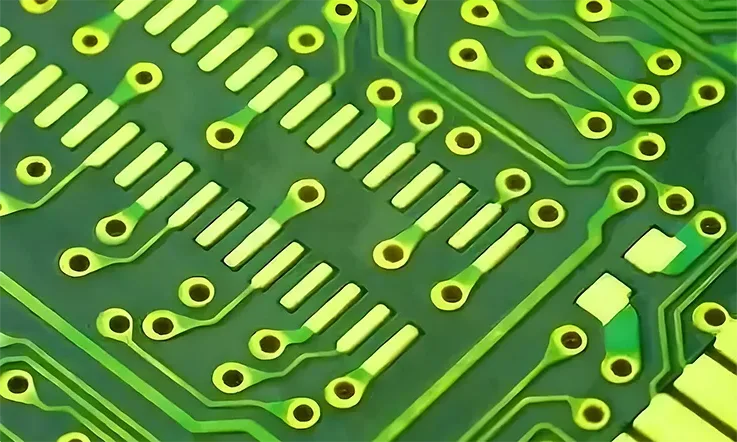
A substrate’s measure is its ability to maintain its properties under real-world operational stresses. For applications exposed to unpredictable temperature swings, vibration, or humidity, E-720 prepregs offer tangible benefits during fabrication, assembly, and deployment.
Thermal Resilience and Dimensional Stability
The material exhibits long-term high-temperature resistance, a fundamental attribute for failure-intolerant applications.
●Stable Glass Transition Temperature (Tg): Maintains a stable Tg after thermal aging or extended heat-soak tests, preventing the material from becoming rubbery and losing its mechanical strength at elevated operational temperatures.
●Low Z-axis CTE: Exhibits a low Coefficient of Thermal Expansion (CTE) in the Z-axis. This minimizes stress on plated-through-hole (PTH) barrels during thermal cycling, reducing the risk of microcracks and ensuring reliable interlayer connections.
●Peel Strength Retention: Retains high peel strength to copper foils even after exposure to multiple lead-free reflow cycles, ensuring trace and pad adhesion.
Electrical Performance and Signal Integrity
Its predictable electrical properties make it suitable for a wide range of high-frequency and high-speed digital applications.
●Stable Dielectric Constant (Dk): The material’s Dk maintains stable values over a wide frequency range, which supports precise impedance control in transmission line design.
●Low Dissipation Factor (Df): A low loss tangent minimizes signal attenuation, preserving the amplitude and integrity of signals as they travel across the board. This is especially beneficial for RF front-ends and long SerDes channels.
●Weave Style Control: The availability of different glass styles allows for the mitigation of fiber weave effect, a phenomenon that can cause timing skew in high-speed differential pairs.
Processability and Manufacturability
Process specialists benefit from the material’s accommodating characteristics during fabrication.
●Simplified Layup: The material’s generous tack life and out-time streamline layup procedures in batch lamination and reduce rework caused by surface dryness or brittleness.
●Void-Free Fill: Its resin flow behavior promotes complete, void-free encapsulation of vias and internal circuit features during lamination, a distinct advantage in mixed-dielectric constructions and RF shielding layouts.
●Structural Support: The system supports complex multilayer circuit configurations by preventing deformation and excessive resin bleed during lamination, leading to more predictable stack-up results and improved registration accuracy.
Design and Layout Optimization for E-720 Circuits
In high-speed and high-reliability systems, PCB layout and material selection directly influence overall performance. To meet design expectations, it’s necessary to match engineering parameters with how the material behaves during fabrication. This section offers layout strategies that reflect the processing traits specific to the E-720 material system.
Layer Stackups and Dielectric Management
A well-structured stackup involves the precise selection of Nelcote E-720 prepreg configurations to manage dielectric spacing, impedance targets, and thermal distribution. The modified epoxy system in E-720 prepregs enables stable thickness control, making it possible to construct circuits for multi-gigahertz applications without unwanted resin migration.
●Predictable Dielectric Spacing: The material’s flow characteristics during lamination enable stable dielectric spacing between signal layers and reference planes throughout an entire fabrication batch.
●Tunable Resin Content: Various prepreg styles within the E-720 family allow for tuning resin content and glass fabric type, affording greater control over total thickness and Z-axis alignment.
●Sequential Lamination Support: For designs requiring sequential lamination, the prepreg’s thermal behavior minimizes inner-layer distortion and dielectric drift, even after multiple press cycles.
Table 1: Prepreg Options for Stackup and Dielectric Control:
| Prepreg Type | Glass Style | Nominal Thickness (mil) | Resin Content (%) | Typical Use Case |
| E-720 2116 | 2116 | ~4.0 | 58–60% | Core-to-prepreg interface, mid-layer builds |
| E-720 1080 | 1080 | ~3.0 | 62–65% | Fine-line impedance control |
| E-720 106 | 106 | ~2.0 | 68–70% | High-frequency or RF inner-layer spacing |
| E-720 No-Flow | Custom | Varies | 40–55% | Used for sequential lamination and rigid-flex |
High-Frequency Signal Routing with E-720 Materials
For high-speed signal paths, the dielectric properties and surface characteristics of Nelcote E-720 support the routing precision needed for SerDes links, RF front-ends, and DDR5-level data paths.
●Stable Dk and Df Values: The E-720 epoxy matrix offers stable dielectric and loss values across a wide frequency spectrum, ensuring signal edges are not degraded as they travel along long traces or through complex transitions.
●Tighter Skew Control: When combined with quartz fabric or spread-glass styles, the material permits tighter skew control and more predictable crosstalk behavior in differential pair routing.
●Fine-Line Etching: The resin system facilitates fine-line etching with minimal glass weave interference, reducing the risk of phase mismatch or routing asymmetry in impedance-controlled traces.
Table 2: Electrical Characteristics for High-Frequency Routing:
| Parameter | Value (Typical) | Frequency Range |
| Dielectric Constant (Dk) | 3.6–3.8 | 1–10 GHz |
| Loss Tangent (Df) | 0.006–0.009 | 1–10 GHz |
| Etch Resolution Capability | ≤ 3 mil lines/spaces | — |
| Differential Pair Skew | <5 ps/inch | <10 GHz |
Design for Manufacturability (DFM) Guidance
A precise electrical layout can underperform if it conflicts with the physical realities of board fabrication. Applying DFM principles is a requirement for a successful outcome when using advanced materials like E-720.
●Utilize Thermal Reliefs and Copper Thieving: In dense inner layers, strategically apply these features to balance copper distribution, manage heat during assembly, and mitigate delamination risk in areas that might otherwise become resin-starved.
●Define Adequate Resin Flow Paths: Ensure sufficient spacing around large copper planes and other dense features. This prevents excess resin squeeze-out and the formation of resin-rich pockets that can affect thickness and planarity.
●Employ Symmetrical Stackups: Construct stackups with symmetrical copper and prepreg arrangements relative to the board’s centerline. This practice counteracts Z-axis expansion forces and prevents board warping during high-temperature reflow soldering.
Table 3: DFM Considerations for E-720 Fabrication:
| DFM Practice | Recommended Value/Range | Purpose |
| Copper Balance (inner layers) | ±10% across panel | Reduces warpage, ensures even lamination |
| Resin Dam Width | ≥15 mil from dense copper edge | Prevents excess resin buildup/squeeze-out |
| Thermal Relief Spoke Width | 6–10 mil | Controls copper heating, improves solderability |
| Layer Symmetry | Mirror copper/prepreg layout | Maintains flatness during reflow and press cycles |
Advanced Thermal Management Strategies for E-720 PCBs
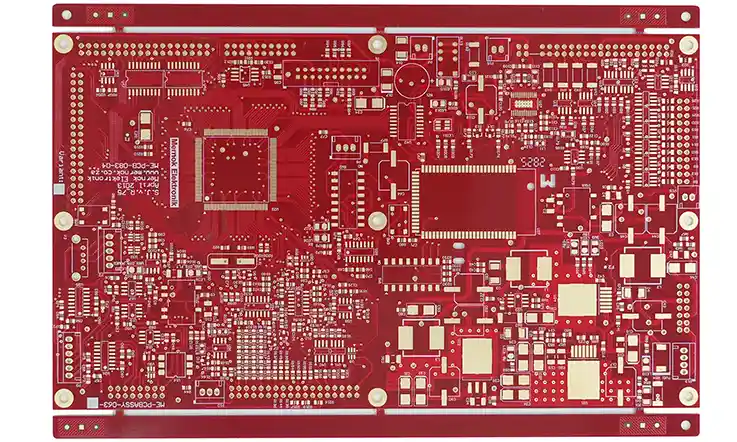
The high Tg of Nelcote E-720 provides a robust thermal foundation, but advanced electronics often require more active thermal dissipation strategies. Integrating these techniques at the board level demands a material system that can withstand the associated fabrication stresses. E-720 is well-suited for such complex thermal management solutions.
Integrating Embedded Coins and Heat Sinks
For high-power components, embedding metal coins (copper or aluminum) directly into the PCB provides a direct, low-resistance thermal path from the component to a heat sink.
●Fabrication Process: This involves creating a cavity in the PCB stackup during lamination and bonding the coin in place. E-720’s controlled flow characteristics are beneficial here, as the resin must flow uniformly around the coin without creating voids or excessive stress.
●Material Compatibility: The CTE of the coin must be managed relative to the E-720 laminate. While not a perfect match, E-720’s mechanical robustness helps accommodate the slight mismatch during thermal cycling without delamination.
●Layout Considerations: The layout must account for isolation spacing between the coin and adjacent electrical features. The lamination profile must be adjusted to ensure a strong bond between the E-720 prepreg and the metal coin.
Heavy Copper and Power Plane Design
Heavy copper planes (3 oz/ft² and above) are used for high-current applications, and they also function as effective heat spreaders.
●Etching Challenges: Fabricating fine features on heavy copper layers is difficult. Advanced etching processes are required to achieve clean trace definition without excessive undercutting.
●Lamination with Heavy Copper: E-720 prepregs with higher resin content are selected to ensure complete encapsulation of the thick copper traces, preventing air gaps that would impede thermal transfer.
●Thermal Spreading: The layout should extend copper planes beyond the footprint of the heat-generating component to maximize the area for heat spreading, leveraging the thermal conductivity of the copper.
Via-in-Pad Plated Over (VIPPO) for Thermal Conduction
Placing thermal vias directly under a component’s thermal pad and filling them with conductive or non-conductive material provides an efficient array of thermal conduits to inner or outer layer ground planes.
●Filling and Capping: The vias are typically filled with a specialized conductive or non-conductive epoxy and then planarized and plated over (capped) with copper. This process must be executed flawlessly to create a flat, solderable surface.
●E-720 as a Base: Nelcote E-720’s dimensional stability during the multiple heating cycles required for via filling and plating is a significant advantage, preventing registration issues or pad lifting.
●Reliability: The low Z-axis CTE of E-720 ensures the long-term reliability of the VIPPO structures, minimizing the risk of fatigue or cracking in the via barrel or its connection to the pad.
The E-720 Fabrication Process: A Technical Breakdown
Processing Nelcote E-720 materials effectively requires specialized controls that go beyond standard FR-4 methodologies. The material’s epoxy system and thermal characteristics demand precise management of pressure, heat, and sequencing at each stage. This section focuses on the practical methods for preparing, pressing, curing, and finishing boards built with E-720 prepreg and laminate combinations.
Prepreg Handling and Layup Protocols
While Nelcote E-720 offers robust properties, its performance can be compromised by improper handling. The material’s sensitivity to humidity and out-time necessitates strict adherence to defined protocols.
●Prepreg Acclimatization: Rolls or sheets must be equilibrated at 22–24°C and 45–55% RH for at least 8–12 hours before layup to prevent moisture-related defects like outgassing during lamination.
●Cleanroom Environment: Layup procedures must occur in a Class 10,000 or better cleanroom. The use of antistatic gloves and backlight inspection is standard to prevent foreign object debris (FOD) between layers.
●Vacuum-Assisted Layup: To remove entrapped air and precisely align the glass weave, vacuum bagging is commonly employed before loading the stackup into the press. This ensures intimate contact between all layers.
Lamination and Cure Cycle Management
Prepregs based on modified epoxy resins like E-720 require tailored cure cycles to activate resin flow and achieve optimal cross-linking density. Before setting cure profiles, the total stack height, resin content, and copper weight are evaluated.
●Controlled Ramp Rates: A gradual temperature ramp-up (e.g., 2-4°C per minute) is advised. Excessively fast heating can induce premature resin gelation, leading to internal stresses and incomplete fill.
●Steady Dwell Periods: Maintaining the specified soak at peak temperature (typically 180-200°C) allows for complete and uniform cross-linking across all interlayers, maximizing the material’s Tg.
●Gradual Cooldown: A controlled cooling phase after cure prevents thermal shock, thereby preserving board flatness and preventing microcracking around vias.
●Pressure Application: Autoclave systems can enhance consolidation pressure through inert gas application, which is beneficial for boards exceeding 20 layers or those with hybrid material stacks. Standard press molding remains an efficient method for less complex builds.
Drilling, Desmear, and Plating for High-Reliability Vias
The integrity of vias is fundamental to a multilayer board’s reliability. The filled resin system of E-720 requires specific drilling and hole preparation techniques.
●Optimized Drilling: Achieving clean holes requires drill bits configured for filled resin systems, along with optimized feed and speed rates to prevent resin smear, fiber fracture, and heat generation.
●Plasma Desmear: A plasma desmear process using a precisely controlled CF4/O2 gas chemistry is highly effective for preparing drilled via walls. It removes smeared resin and texturizes the hole wall, promoting strong plating adhesion for dependable inter-layer connections.
●Electroless Copper Deposition: A high-quality electroless copper process is used to create a conductive base for subsequent electrolytic copper plating, ensuring a void-free and uniformly thick plated barrel.
Mitigating Common Defects in E-720 Fabrication
While technically robust, E-720 materials can present failure risks if fabrication thresholds are exceeded. Understanding and mitigating these potential issues is fundamental to achieving predictable yields and dependable electrical performance.
Failure Mode: Delamination Around Vias or Along Planes
●Common Causes: Excessive lamination pressure; uneven prepreg flow due to unbalanced copper distribution; moisture entrapped in the prepreg.
●Mitigation Strategy: Tune prepreg selection (resin content and flow) to match the circuit’s copper density. Use press simulation models to verify the stackup before lamination. Implement strict pre-bake and acclimatization protocols.
Failure Mode: Resin Starvation
●Common Causes: Insufficient resin available to fill fine-pitch features, especially near dense BGA pads or in large copper planes.
●Mitigation Strategy: Select resin-rich prepreg styles for layers with dense features. Locally adjust the layup architecture or add resin-bearing films (bondply) to targeted areas. Use DFM checks to ensure adequate copper thieving.
Failure Mode: Post-Lamination Warpage
●Common Causes: Asymmetrical copper layout; unbalanced stackup construction; improper press cure profiles with uneven heating or cooling.
●Mitigation Strategy: Enforce symmetrical copper distribution from the board’s centerline. Adjust cure profiles based on board size and overall copper weight to ensure even heat distribution. A post-lamination bake can also relieve internal stresses.
E-720 vs. Other High-Performance Substrates: A Comparative Analysis

Specifying materials for complex multilayer circuits often involves evaluating the trade-offs between Nelcote E-720, Polyimide, BT Epoxy, and standard FR-4. This evaluation affects not just signal behavior or thermal performance, but also how the board responds to drilling, plating, lamination, and reflow.
E-720 vs. Standard FR-4
While FR-4 serves well in many applications, its thermal and electrical limits are quickly reached in demanding systems. Nelcote E-720 occupies a tier for builds requiring greater stability.
●Thermal Performance: E-720 has a substantially higher Tg (typically >180°C) compared to standard FR-4 (~140°C). This provides a larger safety margin during lead-free soldering and in high-temperature operating environments.
●Via Reliability: During assembly, FR-4 boards can exhibit more micro-cracking around plated holes due to higher Z-axis expansion. E-720’s lower CTE demonstrates superior dimensional control.
●Loss Profile: FR-4’s loss tangent increases steeply beyond 2 GHz. The E-720 profile remains relatively flat, making it better suited for RF front-ends or high-speed digital traces where signal attenuation is a concern.
Technical Comparison Table: E-720 vs. Standard FR-4:
| Property | Nelcote E-720 | Standard FR-4 |
| Glass Transition Temp (Tg) | >180 °C | ~135–145 °C |
| Z-Axis CTE (@Tg) | ~2.6% | ~3.5–4.0% |
| Df @ 2–10 GHz | 0.009–0.012 | 0.020–0.025 |
| Dk @ 2–10 GHz | ~3.7–3.8 | ~4.3–4.6 |
| Lead-Free Reflow Capability | Excellent | Limited |
E-720 vs. Polyimide
Polyimide is known for its exceptional thermal resistance, but it presents fabrication challenges that E-720 can circumvent.
●Moisture Absorption: Polyimide is notoriously hygroscopic, absorbing significant amounts of moisture from the air. This necessitates long and carefully controlled bake-out cycles before lamination and assembly to prevent delamination. E-720 absorbs far less moisture, streamlining the manufacturing flow.
●Cost and Processing: Polyimide materials are generally more expensive and can be more difficult to process. They often require higher lamination temperatures and pressures, and their drilling characteristics can be more challenging. E-720 processes more like a high-end epoxy, making it a more cost-effective upgrade from FR-4.
●Dimensional Stability: Polyimide systems can exhibit more material movement under pressure during lamination, making layer-to-layer registration more difficult on large or high-layer-count boards. E-720 holds tighter registration tolerances.
Technical Comparison Table: E-720 vs. Polyimide:
| Property | Nelcote E-720 | Polyimide |
| Moisture Absorption (24h) | <0.10% | 0.30–0.45% |
| Tg | >180 °C | >250 °C |
| Lamination Temperature | ~190–200 °C | 220–230 °C |
| Drilling Wear Factor | Low | High |
| Dimensional Stability | Excellent | Moderate to Poor |
E-720 vs. BT Epoxy
Bismaleimide-Triazine (BT) epoxy is another high-performance material, often used in wire-bondable assemblies and chip packages.
●Mechanical Properties: BT Epoxy is known for its hardness and rigidity, but this can also make it more brittle than E-720. The modified epoxy system of E-720 offers a better balance of toughness and rigidity, making it more resilient to mechanical shock and vibration.
●Dielectric Performance: While both materials offer good high-frequency performance, certain E-720 variants, especially when paired with quartz reinforcement, can offer lower loss tangents (Df) and a more stable dielectric constant (Dk) for extremely sensitive RF and microwave applications.
●B-Stage Prepreg Stability: Compared to some BT Epoxy systems, E-720 offers a more forgiving gel time and out-time. This provides a wider processing window, which is beneficial for complex layups that require more handling time.
Technical Comparison Table: E-720 vs. BT Epoxy:
| Property | Nelcote E-720 | BT Epoxy |
| Df @ 10 GHz | ~0.009–0.011 | ~0.012–0.016 |
| Dk @ 10 GHz | ~3.7–3.8 | ~3.8–3.9 |
| Prepreg Out-Time Window | Wide | Narrow |
| Mechanical Toughness | Balanced | High rigidity, brittle |
| Wire Bonding Compatibility | Limited | High |
Hybrid Constructions: Integrating E-720 with RF and Other Materials
Advanced electronic systems frequently require the integration of different material types within a single PCB stackup to optimize for both cost and performance. E-720’s predictable processing characteristics make it an excellent choice as the core material in these complex hybrid constructions.
Combining E-720 with RF/Microwave Materials
A common hybrid application is to combine E-720 with low-loss RF materials like those from Rogers or Taconic.
●Application: In an RF module, the outer layers might be a Rogers 4350B material for the antenna and RF signal paths, while the inner layers, containing digital control and power circuitry, could be built with Nelcote E-720.
●Fabrication Benefit: This approach confines the expensive RF material only to the layers where it is needed, while leveraging E-720’s mechanical strength, thermal performance, and lower cost for the bulk of the board.
●Bonding Process: A qualified fabrication facility uses specific bondply materials or no-flow E-720 prepregs to bond the dissimilar materials together during lamination, ensuring a strong, void-free interface. Plasma treatment is often used to promote adhesion between the different chemistries.
Technical Comparison Table: E-720 vs. Rogers 4350B in Hybrid Applications:
| Property | Nelcote E-720 | Rogers 4350B |
| Dielectric Constant (Dk @ 10 GHz) | ~3.7–3.8 | 3.48 |
| Loss Tangent (Df @ 10 GHz) | ~0.009–0.012 | ~0.0037 |
| Moisture Absorption | <0.10% | ~0.06% |
| Tg (Glass Transition Temp) | >180 °C | ~280 °C |
| Process Compatibility | Epoxy-compatible | Hydrocarbon ceramic |
Sequential Lamination in Mixed-Material Stackups
Hybrid builds almost always require sequential lamination, where subsets of layers are laminated and processed before being combined into the final stackup.
●Process Flow: For example, an inner core of E-720 layers could be laminated and drilled. Then, outer layers of a different material are added in a subsequent lamination cycle.
●Registration Control: Maintaining layer-to-layer registration across multiple press cycles is a significant challenge. The dimensional stability of E-720 under thermal stress is a major advantage in maintaining the required alignment tolerances.
●Material Behavior: Each material in the stackup has a different cure profile and flow characteristic. The lamination cycles must be carefully engineered to accommodate all materials without causing defects like delamination or excessive stress.
Sequential Lamination Process Parameters (E-720 Core Build):
| Parameter | E-720 Performance |
| Prepreg Gel Time (at 175 °C) | ~90–120 seconds |
| Lamination Temperature | ~190–200 °C |
| Typical Registration Tolerance | ±50 μm (within panel) |
| Press Cycle Repeatability | High |
| Vacuum Lamination Capability | Fully compatible |
Managing CTE Mismatch in Hybrid Builds
A primary challenge in hybrid constructions is the mismatch in the Coefficient of Thermal Expansion (CTE) between different materials.
●The Problem: A significant CTE mismatch can cause the board to warp during thermal cycling or can induce stress on plated vias that pass through the interface of the two materials, potentially leading to barrel cracking.
●Mitigation Strategies: Layouts should use symmetrical stackups whenever possible to balance the stresses. The selection of specific E-720 variants with CTE values closer to the mating RF material can help. Furthermore, sophisticated lamination profiles with very slow cooldown rates can minimize built-in stress.
Thermal Expansion Comparison Table: E-720 vs. Common RF Materials:
| Material | Z-Axis CTE (@50–260 °C) | X/Y CTE (ppm/°C) | Tg (°C) |
| Nelcote E-720 | ~2.6% | ~12–16 | >180 °C |
| Rogers 4350B | ~1.2–1.5% | ~11–14 | ~280 °C |
| Taconic TLY-5 | ~1.0% | ~13 | ~280–300 °C |
Selecting Surface Finishes for High-Reliability E-720 PCBs
The surface finish is the final coating applied to the copper pads of a PCB. It protects the copper from oxidation and provides a solderable surface for component assembly. For high-reliability boards built on E-720, the choice of surface finish is a technical decision that impacts performance, reliability, and cost.
ENIG (Electroless Nickel Immersion Gold)
ENIG is one of the most common finishes for high-reliability applications and is highly compatible with E-720.
●Structure: It consists of a layer of electroless nickel followed by a thin layer of immersion gold. The gold protects the nickel from oxidizing, and the nickel provides the solderable surface.
●Advantages: Offers a very flat (planar) surface, making it ideal for fine-pitch BGA and QFP components. It has a long shelf life and is highly resistant to corrosion.
●Considerations: The process must be tightly controlled to prevent “black pad,” a potential defect where the nickel layer can corrode, leading to weak solder joints. This is a process control issue, not a material incompatibility with E-720.
ENEPIG (Electroless Nickel Electroless Palladium Immersion Gold)
ENEPIG is often called the “universal finish” and is a step up from ENIG, particularly for assemblies requiring wire bonding.
●Structure: It adds a layer of electroless palladium between the nickel and gold. The palladium layer acts as an additional barrier, preventing nickel migration and improving the integrity of the gold layer.
●Advantages: ENEPIG is fully compatible with both lead-free soldering and gold or aluminum wire bonding, making it suitable for complex hybrid assemblies. It offers exceptional reliability and eliminates the risk of black pad.
●Application: Specified for the most demanding aerospace, medical, and defense applications where multiple assembly processes (soldering and wire bonding) are performed on the same board.
IS (Immersion Silver) and OSP (Organic Solderability Preservative)
While less common for the highest-reliability E-720 applications, these finishes have specific use cases.
●Immersion Silver: Offers excellent planarity and good performance for high-frequency applications, as it has very low signal loss. However, it is susceptible to tarnishing and requires careful handling in a controlled environment.
●OSP: This is an organic coating that protects the copper before soldering. It is a cost-effective and environmentally friendly option but has a limited shelf life and cannot withstand multiple reflow cycles as well as metallic finishes. It is generally not recommended for high-stakes E-720 applications.
Quality Assurance and Reliability Testing for E-720 Assemblies
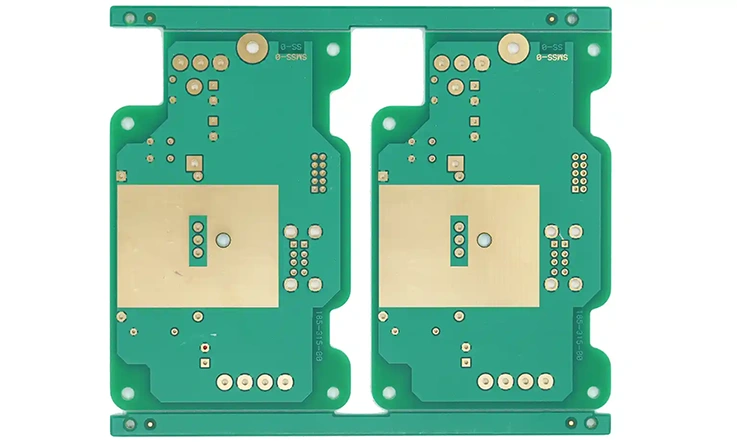
For high-reliability sectors, fabricating a board is not enough; its quality and long-term durability must be verified. A robust quality assurance program, including destructive and non-destructive testing, is a hallmark of a qualified E-720 fabrication service. These tests validate the integrity of the materials and the manufacturing processes.
Cross-Sectional Analysis for Verification
Micro-sectioning, or cross-sectioning, is a destructive test that provides a detailed view of the board’s internal structure.
●Process: A coupon or a section of a finished board is cut out, mounted in an epoxy puck, and polished to reveal a cross-section of the layers and vias.
●What It Verifies: This analysis allows for the inspection of layer-to-layer registration, dielectric thickness, copper plating thickness in via barrels, the quality of the lamination (checking for voids or delamination), and the integrity of the via-to-pad connection.
●E-720 Context: For E-720 boards, cross-sections are used to confirm that the resin flow was adequate, that the plasma desmear process effectively cleaned the via holes, and that the Z-axis expansion has not caused any stress fractures after simulated reflow testing.
Interconnect Stress Testing (IST) and Thermal Shock
These tests are designed to accelerate the failure mechanisms that boards experience over their operational life due to thermal cycling.
●IST: An IST system repeatedly passes high current through a specific network of vias and traces on a test coupon, rapidly heating and cooling the internal structure. It measures the resistance change to detect failures like via cracks or pad lifting in real-time.
●Thermal Shock: This test involves rapidly moving the test board or coupon between chambers set at extreme cold and hot temperatures (e.g., -65°C to +150°C). This stresses the material interfaces and via structures.
●Value for E-720: Passing these tests provides high confidence that the selected E-720 material and the fabrication processes used can withstand the thermal stresses of the intended application environment.
Time-Domain Reflectometry (TDR) for Impedance Validation
For high-speed digital circuits, verifying that the fabricated trace impedance matches the layout specification is non-negotiable.
●Methodology: A TDR instrument sends a fast-rising pulse down a test trace on a coupon and analyzes the reflections. The shape and timing of the reflections indicate the impedance at every point along the trace.
●Process Control: Consistent TDR results across a panel and from batch to batch demonstrate tight process control over trace width, dielectric thickness, and the dielectric constant of the E-720 material as processed.
●Why It Matters: An impedance mismatch can cause signal reflections, degrading signal integrity and leading to bit errors in a high-speed system. TDR testing provides objective proof of performance.
Real-World Applications of Nelcote E-720
Nelcote E-720 is specified not just for its datasheet properties, but for how it performs in industries that require dimensional precision, signal integrity, and long-term stability.
Aerospace and Defense Systems
In this sector, reliability is non-negotiable. Boards are exposed to extreme temperature cycles, shock, and vibration.
●Avionics and Flight Controls: E-720’s low Z-axis CTE ensures the reliability of PTHs and microvias through thousands of thermal cycles from ground to altitude.
●Satellite Communications: Its low-loss dielectric properties and low outgassing characteristics are suited for RF modules and backplanes deployed in the vacuum of space.
●Radar and Electronic Warfare: The material’s stable Dk allows for the fabrication of predictable phased-array antenna elements and high-frequency signal processing boards.
Medical Electronics: Diagnostic and Imaging Devices
Medical-grade electronics demand tight process control, low outgassing, and stable performance under sterilization.
●MRI and CT Systems: Multi-layer circuits using E-720 prepreg maintain stable impedance characteristics across high-frequency signal paths, even after repeated exposure to sterilizing heat cycles.
●Implantable Device Programmers and Monitors: The material’s reliability and biocompatibility (when properly processed) make it a candidate for external apparatus that interfaces with life-sustaining products.
●Embedded Imaging Control Units: Controlled resin flow behavior during lamination supports dense via-in-pad layouts, which are common in compact optical assemblies for endoscopy and surgical tools.
Automotive ECUs and Sensors
Automotive electronics operating near engines or high-load power rails face continuous thermal cycling and sustained vibration.
●Powertrain Control Units (ECUs): The high Tg of E-720 reduces CTE mismatch stress between copper and dielectric, limiting the risk of delamination over the vehicle’s lifecycle.
●ADAS Radar and Lidar Modules: E-720’s stable dielectric properties help preserve high-frequency signal shape across traces, especially in systems operating near 77 GHz where phase accuracy is needed.
●Battery Management Systems (BMS): For electric vehicles, E-720 provides the thermal robustness to withstand the heat generated during high-current charging and discharging cycles.
Cost Analysis and Procurement Planning for E-720 Projects
Forecasting the total cost for circuit boards built with Nelcote E-720 extends beyond the raw laminate price. As this is a high-performance thermoset system, factors such as resin content, glass weave, and prepreg flow behavior all affect cycle time, yield, and ultimately, the final board cost.
Understanding Cost Drivers: Material and Process
Three primary technical elements influence the pricing structure when building with Nelcote E-720.
●Resin and Reinforcement Selection: Higher Tg versions or modified variants carry a higher cost. Quartz fabric is substantially more expensive than fiberglass. Finer glass styles (e.g., 106, 1080) also command a premium over standard weaves.
●Stackup Complexity: The number of layers, the inclusion of blind/buried vias, and the requirement for multiple sequential lamination cycles directly increase processing time and cost.
●Panel Utilization: The efficiency with which individual boards are nested onto a standard fabrication panel affects material waste. Non-standard board geometries or poor nesting can significantly increase the per-board cost.
Estimating Lead Times for Prototype and Volume Orders
Turnaround windows for Nelcote E-720 boards are affected by material availability and fabrication complexity.
●Prototypes (1–10 Panels): A typical turnaround is 7–12 working days, assuming standard glass types (e.g., 2116 or 7628) are used and the lamination process is already qualified.
●Mid-Volume (50–200 Panels): An additional 5–8 working days are often required for layered stack registration, soldermask cure coordination, and plating adjustments, especially for boards involving sequential lamination.
●Custom Material Orders: Prepreg variants with custom resin percentages or non-standard weaves (like quartz) often require a 3–4 week advance call-out from the material supplier to avoid air-freight charges or scheduling delays.
Lead Time Estimation Table:
| Order Type | Panel Quantity | Base Lead Time | Notes |
| Prototype | 1–10 | 7–12 working days | Standard prepreg (2116, 7628) only |
| Mid-Volume | 50–200 | 12–16 working days | Includes extra drill/soldermask |
| Custom Resin/Glass | Any quantity | 3–4 weeks (advance material booking) | For quartz weave or modified resin |
Budgeting and Sourcing Strategies for Volume Builds
For entities managing multi-phase rollouts, E-720 boards should be treated as part of a larger cost-control strategy.
●Employ Hybrid Stackups: Use E-720 selectively only in thermally or electrically sensitive zones (e.g., the RF portion of a board), while combining it with other epoxy systems like FR408HR where performance demands are lower. This can substantially reduce panel cost.
●Optimize Panel Nesting: Work with the fabrication facility to optimize the nesting arrangement on the fabrication panel. A small adjustment to board dimensions can sometimes dramatically improve panel yield.
●Include Lamination Trials in Budgets: For highly complex or high-layer-count layouts, including a small budget for trial presses or test coupons can ensure higher yields and prevent costly failures during the main build.
Volume Build Budgeting Table:
| Strategy | Impact on Budget | Estimated Savings/Overhead |
| Hybrid Stackup (E-720 + FR408HR) | −10% to −30% | Reduces raw laminate cost significantly |
| Panel Nesting Optimization | −5% to −20% | Better nesting increases yield |
| Lamination Trials/Test Coupons | +2% to +5% upfront | Minimizes rework during volume build |
Selecting a Fabrication House for Nelcote E-720
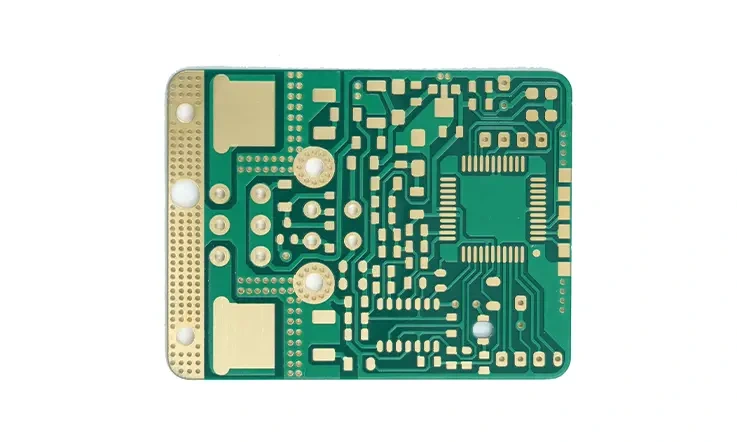
For PCBs built with Nelcote E-720, the final outcome is determined less by the material itself and more by the chosen facility’s command of its unique processing characteristics. The right service goes beyond simply sourcing prepregs—it must have proven techniques for managing E-720’s specific resin flow, cure profiles, and interlayer integrity.
How to Evaluate a Vendor’s E-720 Capabilities?
Not every facility that stocks E-720 has the technical depth to realize its full performance potential. The most telling indicator is the experience built around its lamination and post-processing behavior.
●Thermoset Processing Experience: The vendor should show evidence of successful runs using advanced B-stage epoxy systems in high-layer-count (12+) configurations.
●Thermal Control and Lamination Equipment: The facility must have presses with precise thermal profiling capabilities and vacuum systems (or autoclaves) to ensure void-free lamination.
●Inner-Layer Preparation Processes: The vendor should have defined processes for controlled oxide, copper surface roughening, and pre-etch compensation that work in concert with E-720’s flow window.
●Drill-to-Plating Integrity: The service should be able to present results from thermal shock, HATS (Highly Accelerated Thermal Shock), or interconnect stress tests (IST) showing stable vias without barrel cracks or failures.
Questions to Pose to a Potential Fabrication Service
Asking specific technical questions can reveal how well a vendor has mastered E-720’s fabrication behavior.
●Material Stock and Variants: “Which Tg variants of Nelcote E-720 do you stock? Are multiple glass styles (e.g., 106, 1080, 2116) available to tune performance?”
●Process Control: “Are your lamination curves fully defined, including ramp, dwell, and cooldown stages? Do you use autoclave or vacuum-assisted systems for high-layer-count boards?”
●DFM and Simulation: “For high-density layouts, how is the risk of resin starvation around fine-pitch features mitigated? Is resin flow simulated in advance of the build?”
●Material Data: “Are the dielectric and loss values you use for impedance modeling based on in-house testing and characterization, or are they solely from datasheets?”
●Hybrid Constructions: “Can E-720 be combined with other core materials (e.g., Rogers 4350B or polyimide) in hybrid constructions? Do you have compatibility data and established processes for such builds?”
Begin a Technical Consultation
The success of your project depends on specialized expertise. Discuss your unique design and fabrication requirements with process specialists to ensure optimal results.
→ Request a Technical Consultation
Future Trends: The Role of E-720 in Next-Generation Electronics
The evolution of electronics is defined by a push toward devices that demand higher integration and enhanced thermal management. Nelcote E-720 materials are integral to these advancements, offering a balance between advanced resin chemistry and reliable mechanical support.
Supporting Miniaturization and High-Density Interconnects (HDI)
Miniaturization challenges the limits of circuit board construction, demanding materials that maintain structural integrity in thinner form factors.
●Thinner Prepregs: E-720’s modified epoxy system supports thinner prepregs with controlled resin flow that adapt well to fine-pitch and high-layer-count HDI boards.
●Precise Dielectric Control: This enables the tight impedance matching and layer registration required for dense signal routing with features like stacked and staggered microvias.
●Enhanced Assembly Stability: The material’s thermal stability during soldering and reflow minimizes warpage and assembly defects, which become more pronounced in thinner, more densely populated boards.
E-720 in EV, Space, and 6G-Enabled Systems
Electronics in electric vehicles, next-generation wireless infrastructure, and low-Earth orbit (LEO) satellites face stringent thermal and mechanical demands.
●High-Voltage EV Inverters: E-720’s high Tg and superior CAF (Conductive Anodic Filament) resistance are suited for the power electronics in EVs that operate at high voltages and temperatures.
●Active Antennas for 6G: As frequencies move into the sub-terahertz range, materials with extremely low and stable loss tangents, like quartz-reinforced E-720, will be specified for antenna and front-end modules.
●Commercial Space Platforms: The demand for high-throughput LEO satellite constellations requires cost-effective, high-reliability materials. E-720 provides a balance of performance and processability needed for volume builds of space-grade hardware.
Material Innovations and the Evolving Nature of Modified Epoxies
PCB material science is not static. Modified epoxy systems like Nelcote E-720 evolve alongside shifting fabrication methods and application requirements.
●Tailored Resin Formulations: Future developments will focus on formulations that further optimize the balance between thermal performance, signal integrity, and manufacturability, potentially offering even lower loss or higher thermal conductivity.
●Hybrid Prepreg Constructions: The blending of E-720 with novel reinforcements or fillers (e.g., ceramic or hollow-core microspheres) will achieve targeted dielectric constants and mechanical properties for highly specialized applications.
●Sustainable Chemistry Approaches: Research is ongoing to develop high-performance resin systems with reduced environmental impact, both in their chemical composition and manufacturing processes, while preserving all performance characteristics.
Achieving Excellence in E-720 Fabrication: The JarnisTech Advantage
Translating the demanding requirements of a high-performance layout into tangible, reliable hardware necessitates more than just advanced materials. It requires a fabrication approach where process control, technical depth, and a collaborative spirit converge. JarnisTech embodies this approach, transforming the theoretical potential of Nelcote E-720 into realized performance.
From Theory to Reality: Advanced Process Capability
The complex procedures detailed in this guide—such as sequential lamination for hybrid constructions, embedded coin integration, and achieving tight registration on high-layer-count boards—are not theoretical possibilities. They represent the core of our daily fabrication practices. Our process controls and equipment are specifically calibrated to manage the nuanced behavior of high-performance thermosets like E-720.
Verifiable Quality as a Core Principle
A commitment to quality is substantiated by data. The cross-section analyses, Interconnect Stress Tests (IST), and Time-Domain Reflectometry (TDR) measurements discussed previously are integral to our quality assurance protocol. We provide not just a finished product, but a comprehensive data package that validates its integrity and performance against the most stringent standards.
Efficiency and Value: Beyond Price and Delivery
For high-stakes applications, true value lies in predictability and reliability. At JarnisTech, competitive lead times and cost-effectiveness are the natural results of a highly optimized and intelligent manufacturing workflow. Our focus is on delivering superior total value, where on-time delivery is a function of a well-managed process, not a compromise on quality.
A Collaborative Technical Partnership
We offer more than a simple client-vendor service; we provide a proactive technical partnership. This collaboration begins with early-stage DFM (Design for Manufacturability) reviews to identify and mitigate potential fabrication risks before they impact the schedule or budget. It continues with transparent communication throughout the build cycle and extends to post-delivery support, ensuring your design intent is perfectly realized from start to finish.
Achieving Predictable Fabrication with Nelcote E-720
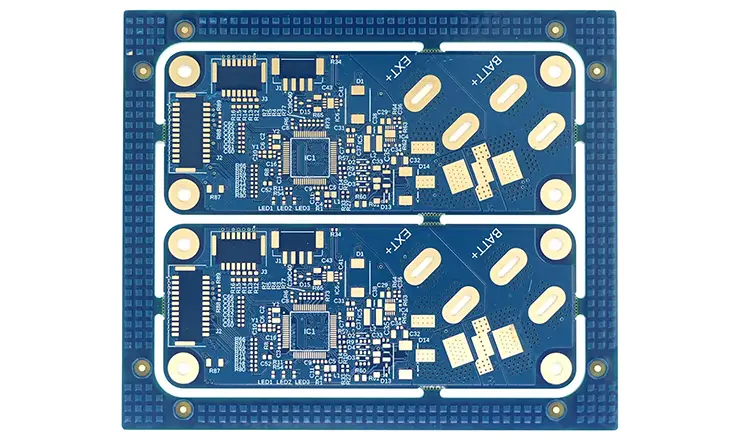
Specifying Nelcote E-720 is a sound choice for circuits operating in demanding environments. Its superior thermal stability, predictable electrical properties, and robust mechanical nature provide a foundation for reliable performance where standard materials fall short. However, the material itself is only half of the equation.
The ultimate success of a project hinges on the fabrication flow. A deep, practical command of how E-720 behaves during lamination, drilling, and plating is what separates a standard board from a truly dependable one. Engaging a fabrication service that possesses this specialized expertise—one with documented process controls, advanced equipment, and a history of success with complex, high-layer-count E-720 constructions—is the most direct path to achieving layout objectives, reducing manufacturing risk, and ensuring the long-term field reliability of high-specification electronic systems.
FAQs for Nelcote E-720 Fabrication
Q: How can resin smear be reduced when drilling Nelcote E-720?
A: Use high spindle speeds with low feed rates, and select drill bits designed for high-Tg materials (e.g., U-flute bits). E-720 generates more heat than FR-4, so rapid chip removal is fundamental to minimizing melted resin adhesion.
Q: How is the risk of “black pad” mitigated during ENIG plating on E-720 substrates?
A: Control the nickel bath’s phosphorus content and pH. While E-720’s resin system is robust against plating chemistry, a pre-ENIG micro-etching step is recommended to promote a uniform nickel layer and reduce risk.
Q: In hybrid lamination (e.g., E-720 with PTFE), how is resin flow controlled to avoid contaminating the PTFE surface?
A: A no-flow or low-flow prepreg/bondply layer can be added between the E-720 prepreg and the PTFE core. The lamination heat ramp and pressure profile must also be precisely designed to manage flow.
Q: Can fine-line traces on an E-720 board be repaired? What are the considerations?
A: Yes, but it is challenging. Its high Tg and strong bond require higher temperatures and longer dwell times for hand-soldering. Use localized heating tools and specialized operator training to prevent thermal damage or pad lifting.
Q: How does etch undercut control for E-720 compare to Polyimide?
A: Due to a denser resin-to-copper bond, E-720 typically exhibits less undercut than flexible Polyimide in standard etch chemistries. This gives it a slight advantage in fine-line width control.
Q: For laminating E-720, what is the effect of using steel caul plates versus press pads on flatness?
A: For thin cores or high layer counts, precision-ground steel caul plates provide more uniform heat and pressure distribution, resulting in superior flatness and thickness tolerance.
Q: What is the recommendation for depaneling quartz-reinforced E-720 boards?
A: Diamond wheel routing or laser cutting is recommended. The toughness of quartz fabric drastically reduces the life of V-cut blades and punching dies and can cause edge fracturing.
Q: Does the hole wall of an E-720 board require a more aggressive activation process than FR-4 before plating?
A: Generally, yes. The drilled hole wall of E-720 is very smooth. After desmear, a more effective palladium catalyst or a longer immersion time is needed to ensure sufficient catalyst coverage for the subsequent electroless copper plating.

